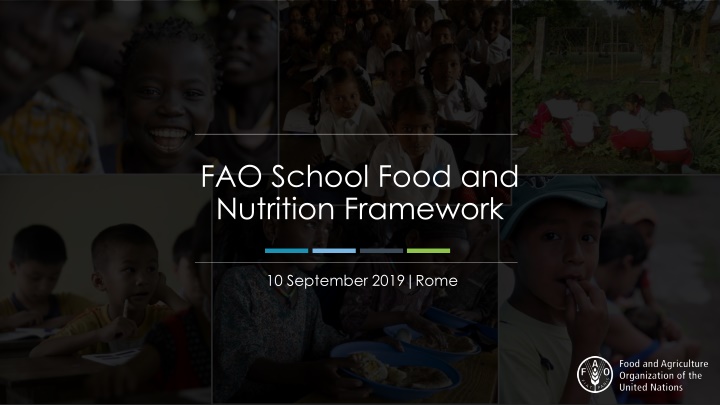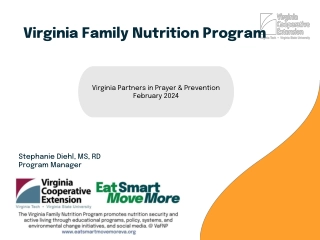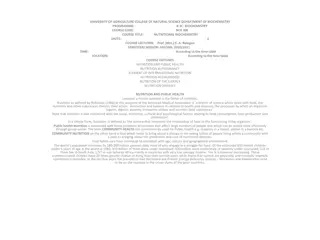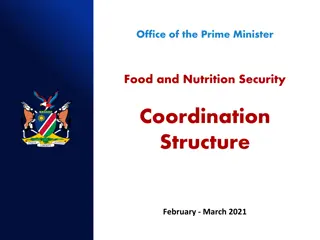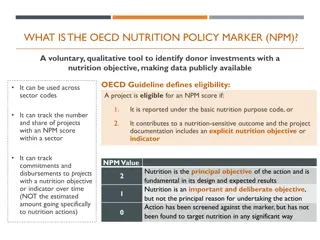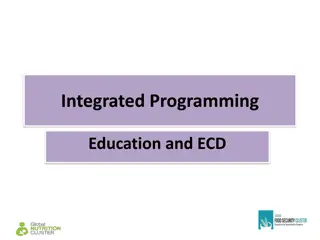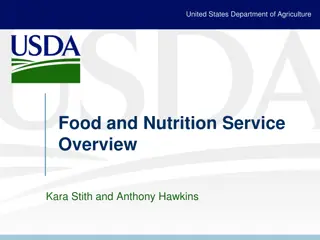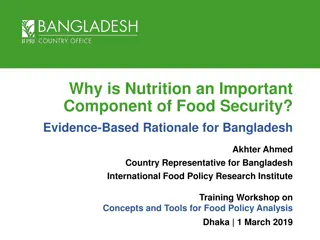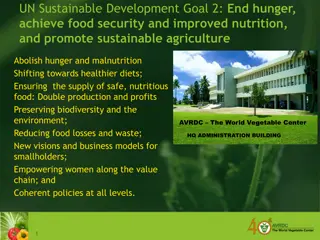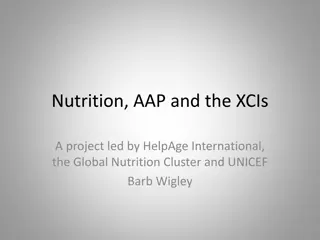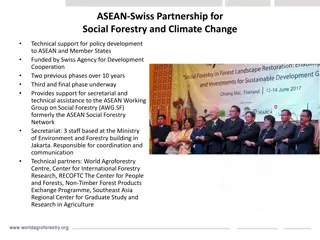Enhancing School Food and Nutrition Initiatives for Sustainable Development
Schools play a crucial role in advancing nutrition and development through holistic food and nutrition programs. These programs, identified as a triple-duty action, address malnutrition and development challenges, contributing to multiple Sustainable Development Goals. FAO emphasizes the importance of school-based initiatives in improving food security, nutrition, and socio-economic development within communities. The framework focuses on areas of expertise along the food system, capitalizing on existing models, and building on lessons learned to create sustainable and inclusive procurement practices and value chains.
Download Presentation

Please find below an Image/Link to download the presentation.
The content on the website is provided AS IS for your information and personal use only. It may not be sold, licensed, or shared on other websites without obtaining consent from the author.If you encounter any issues during the download, it is possible that the publisher has removed the file from their server.
You are allowed to download the files provided on this website for personal or commercial use, subject to the condition that they are used lawfully. All files are the property of their respective owners.
The content on the website is provided AS IS for your information and personal use only. It may not be sold, licensed, or shared on other websites without obtaining consent from the author.
E N D
Presentation Transcript
FAO School Food and Nutrition Framework 10 September 2019|Rome
Background Schools as a priority setting for advancing nutrition and development (ICN2, 2014, FAO & WHO, 2015, Decade on Nutrition, 2016, GLOPAN, 2016) School feeding is globally widespread (representing an important public and donor investment) Many programmes have evolved and transitioned to incorporate complementary actions and synergies that are conducive to multi-win outcomes (GLOPAN, 2016) Holistic school-based food and nutrition programmes, identified as a triple duty action, which tackles malnutrition and other development challenges, yielding multiple benefits across the Sustainable Development Goals (SDG). SDGs 1 (No Poverty), 2 (Zero Hunger), 3 (Good Health and Well-being), 4 (Quality Education), 8 (Decent Work and Economic Growth) and 10 (Reduced Inequalities)
The opportunity Areas of expertise along the food system Capitalizing on existing models Experience from country support Linking areas of work Building on lessons learned
Terminology The term school food and nutrition encompasses complementary and synergistic efforts to improve food security and nutrition through schools as well as local community socioeconomic development. The notion of SFN goes beyond a single policy or programme, to include a portfolio of coherent actions and interventions that can be implemented through various mechanisms. E.g. public health policies, national basic education curricula, school policies, school meal or home-grown school feeding programmes, catering systems and subnational processes that link smallholder producers to schools.
FAOs areas of work in school food and nutrition In support of Improved food outlooks, practices and capacities Improved nutrition and well-being Community socioeconomic development Local food systems conducive to better diets
Inclusive procurement and value chains OBJECTIVES Provide school meals with safe, nutritious, diverse, acceptable and locally produced foods, prioritizing available supply from smallholder farmers and small and medium enterprises Create market and financial opportunities for local smallholder producers contributing to community economic development STAKEHOLDERS Agriculture, Health, Food Safety, Education, Procurement, Finance, Trade, Local governments, Civil Society, Community, Partners FAO SUPPORT Technical support on production, post-harvest, storage, processing, organizational and marketing skills Technical support for market diversification/nutrition sensitive value chain development Technical support for the development of an enabling food safety control environment and capacity to enhance compliance (of stakeholders) along the value chain Guidance on the design and implementation of smallholder-friendly procurement mechanisms Capacity development and training materials (for FOs, procurement authorities; schools, local and national governments) Monitoring, evaluation and evidence generation
Healthy food environment and school food OBJECTIVES Ensure that food available in the school is safe and aligned with the nutritional priorities of schoolchildren and adolescents. Foster a healthy food environment within the school premises and beyond. STAKEHOLDERS Education, Health, Food Safety, Agriculture, Social Protection, WASH, PTA, Community, Student associations, Civil society, Partners FAO SUPPORT Promotion of healthy food environments, through specific food policies Promotion of coherence between school food environment policies, food provided (e.g. school meals) and sold in the school and national food-based dietary guidelines (where relevant) Technical support for developing, implementing and monitoring nutrition standards and guidelines for school food and meals Technical support and capacity development for menu planning and recipe development (translating guidelines) Capacity development and development of training materials Monitoring, evaluation and evidence generation
Food and nutrition education OBJECTIVES Foster lasting, food-related outlooks, skills and practices for better health and wellbeing in schoolchildren and families. Empower school actors to be agents of change in their local food systems STAKEHOLDERS Education, Health, Agriculture, Social Protection, WASH, Local governments, PTA, Community, Student associations, Civil Society, Partners FAO SUPPORT Awareness raising and advocacy at different levels Support for integrating food and nutrition education in relevant policies (including the national school curriculum) Guidance for the effective design, implementation and monitoring of quality school-based food and nutrition education and other behaviour change interventions Promotion of active involvement of families, community and school staff Promotion of explicit linkages between policy, procurement, school food and the food environment Capacity development and development of training and learning materials Monitoring, evaluation and evidence generation
Enabling policy, legal and institutional environment OBJECTIVES Improve accountability across sectors and institutions for SFN Support countries to adopt evidence based policies, legal and institutional frameworks to effectively implement comprehensive school-based programmes dealing with food and nutrition Advocate for enhanced awareness and knowledge to strengthen political and financial commitment STAKEHOLDERS Agriculture, Health, Food Safety, Education, Social affairs, Trade, Finance, Parliamentarians, Local Governments, Gender FAO SUPPORT Provide advice on the development, revision and adoption of national, regional, or global policies, and legal and regulatory frameworks on SFN (considering agriculture, food system policies and programmes and all components of the SFN approach) Promote improved coordination mechanisms for delivery Develop/review policies and legal frameworks and facilitate and build capacity for effective evidence-based implementation Advocate for appropriate allocation of financial, human and material resources for desired impact Monitoring, evaluation and evidence generation
Social and community participation (the school community) Priority for the most vulnerable (considering food insecurity, socioeconomic disparities, gender, ethnicity, migration, displacement status, and crises and post-crises situations). Should be considered and planned for at each stage of the programme/project cycle with defined mechanisms Key to sustainability and scaling of programmes Essential for expanding some benefits of the programme to the household (e.g. healthy food and food safety practices, homestead production and consumption of nutritious crops, attitudes towards diversified diets) Potential to change, update and improve local and school policies Active involvement versus passive involvement
Linkages to other areas and partnerships Health interventions (including deworming, supplementation) Water, sanitation and hygiene (WASH) interventions Lifestyle interventions Infrastructure development
SFN Synergies Q & A In support of Improved food outlooks, practices and capacities Improved nutrition and well-being Community socioeconomic development Local food systems conducive to better diets
Resources FAO s School Food and Nutrition website FAO School Food and Nutrition Framework Aligning public procurement rules and practices to support the implementation HGSF initiatives: The case of Ethiopia Stepping up school-based food and nutrition education: International Expert Consultation Report Nutrition guidelines and standards for school meals Home-Grown School Feeding Aligning policy and legal frameworks for supporting smallholder farming through public food procurement Regional overview of national school food and nutrition programmes in Africa PAA Africa s contributions to the consolidation of PRONAE in Mozambique Schools as a System to Improve Nutrition
Resources Nutrition and food systems Leveraging institutional food procurement for rural transformation Leveraging institutional food procurement for linking small farmers to markets Influencing food environments for healthy diets Institutional Procurement of Food from Smallholder Farmers: The Case of Brazil School feeding and possibilities for direct purchases from family farming Eating well for good health Promoting healthy diets through nutrition education and changes in the food environment: an international review of actions and their effectiveness A new deal for school gardens Setting up and running a school garden: Teaching toolkit Nutrition Education in Primary Schools
